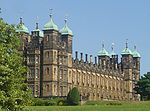
Charles Lapworth FRS FGS was a headteacher and an English geologist who pioneered faunal analysis using index fossils and identified the Ordovician period.

The Great Exhibition of the Works of Industry of All Nations, also known as the Great Exhibition or the Crystal Palace Exhibition, was an international exhibition that took place in Hyde Park, London, from 1 May to 15 October 1851. It was the first in a series of World's Fairs, exhibitions of culture and industry that became popular in the 19th century. The event was organised by Henry Cole and Prince Albert, husband of Victoria, Queen of the United Kingdom.

Princess Marina, Duchess of Kent was a Greek and Danish princess by birth and a British princess by marriage. She was a daughter of Prince Nicholas of Greece and Denmark and Grand Duchess Elena Vladimirovna of Russia, and a granddaughter of King George I and Queen Olga of Greece. Princess Marina married Prince George, Duke of Kent, fourth son of King George V and Queen Mary, in 1934. They had three children: Prince Edward, Princess Alexandra, and Prince Michael.
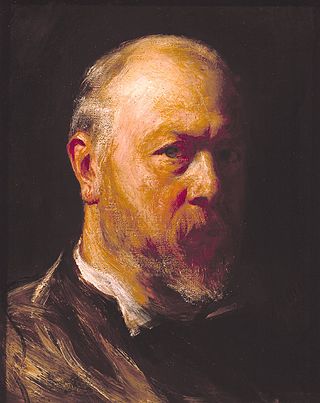
John Pettie was a painter from Edinburgh who spent most of his career in London. He became a member of the Royal Academy in 1866 and a full academician in 1874.
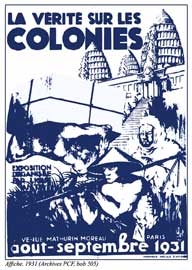
A colonial exhibition was a type of international exhibition that was held to boost trade. During the 1880s and beyond, colonial exhibitions had the additional aim of bolstering popular support for the various colonial empires during the New Imperialism period, which included the scramble for Africa.
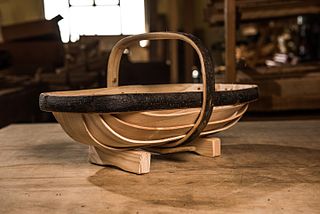
A Sussex trug is a wooden basket. It is made from a handle and rim of coppiced sweet chestnut wood which is hand-cleft then shaved using a drawknife. The body of the trug is made of five or seven thin boards of white willow, also hand-shaved with a drawknife. They may have originated in Sussex because of the abundance of chestnut coppice and willows found on the marshes. Nails or pins used are usually copper, to avoid rust.
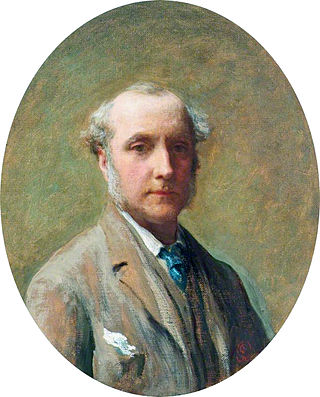
James Sant (1820–1916) was a British painter specialising in portraits and known particularly for images of women and children and artistic exploration of the symbolism of childhood. He was a member of the Royal Academy. George Sant and Sarah Sant were also artists and are believed to have been his brother and sister.

Hugh Francis Clarke Cleghorn was a Madras-born Scottish physician, botanist, forester and land owner. Sometimes known as the father of scientific forestry in India, he was the first Conservator of Forests for the Madras Presidency, and twice acted as Inspector General of Forests for India. After a career spent in India Cleghorn returned to Scotland in 1868, where he was involved in the first ever International Forestry Exhibition, advised the India Office on the training of forest officers, and contributed to the establishment of lectureships in botany at the University of St Andrews and in forestry at the University of Edinburgh. The plant genus Cleghornia was named after him by Robert Wight.

Aphananthe aspera, commonly known as scabrous aphananthe or muku tree, is a flowering plant in the family Cannabaceae. It is found on slopes and stream banks between 100 and 1600 m. It is native to China, Taiwan, Japan, Korea, and Vietnam.

The Scottish Exhibition of National History, Art and Industry was held in Glasgow in 1911. It was the third of 4 international exhibitions held in Glasgow, Scotland during the late 19th and early 20th centuries.

Glasgow Art Club is a club in Glasgow for artists and non-artists interested in creating art and the enjoyment of art - all illustrative arts, sculptures, poetry, prose, plays, music, song, choreography and dance. To advance, promote and encourage the arts in all forms. It has ranges of exhibitions, events and concerts, open to the public for their enjoyment; and, subject to club events, a number of its rooms are available as venues for social occasions.

The International Inventions Exhibition was a world's fair held in South Kensington in 1885. As with the earlier exhibitions in a series of fairs in South Kensington following the Great Exhibition, Queen Victoria was patron and her son Albert Edward, the Prince of Wales, was president of the organising committee. It opened on 4 May and three and three-quarters of a million people had visited when it closed 6 months later.
Events from the year 1884 in Scotland.

The International Exhibition of Industry, Science and Art was a World's fair held in Edinburgh, Scotland in 1886.

John Hutchison was a Scottish sculptor based in Edinburgh. He was the son of an unnamed builder, and his artistic life began as a thirteen-year-old woodcarving apprentice. He attended art school in the evenings, then later became a student at the Trustees Academy. and attracted the patronage of its owner, Patrick Allan Fraser, who gave him commissions to fund his study in Rome. Although after Rome he continued to enjoy ancient Roman sculptural themes, he remained in Edinburgh for the rest of his life, working in wood, clay and marble, and concentrating on portraiture of Scottish people, and images of Scottish myth and history. He created the bust of Sir Walter Scott in Poets' Corner in Westminster Abbey. He was a successful artist who received commissions from Queen Victoria.

The International Fisheries Exhibition was a Victorian era scientific, cultural, and animal exhibition open in South Kensington, London, United Kingdom, between May 12 and October 31, 1883. One of many world's fairs that took place in the second half of the nineteenth century, the exhibition was the largest special event held in the world to that point, attracting 2.6 million visitors, an average of 18,545 per day. The grounds of the exhibition encompassed 21 acres (0.085 km2) of the Royal Horticultural Society grounds in South Kensington, site of the 1862 International Exhibition. Many of the exhibitions on display were based upon the Buckland Museum of Economic Fish Culture, a private collection at South Kensington, and were expanded upon by exhibits from thirty-one countries and colonies. The exhibition attracted attention not only for the variety of fish species and fishing equipment on display, but also for technological achievements such as the widespread use of electric lighting.

Florence St John Cadell was a Scottish artist and patriot, involved in the early days of the Scottish National Party with her partner Wendy Wood. Her artworks are usually signed St John Cadell, disguising her femininity.
John Ednie Brown, (1848–1899) J.P., F.L.S., was an author on sylviculture and state conservator of forests.
Gladys Caroline Barron née Logan (1884–1967) was an English sculptor and painter renowned for her portraiture.
